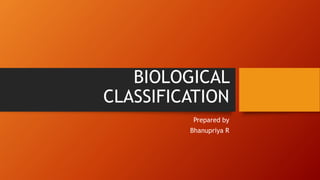
CLASS 11. 2. BIOLOGICAL CLASSIFICATION.pptx
- 3. THREE KINGDOM CLASSIFICATION – ERNST HAECKEL
- 6. 5 KINGDOM • The main criteria for classification used by him include cell structure, body organisation, mode of nutrition, reproduction and phylogenetic relationships. • All prokaryotic organisms were grouped together under Kingdom Monera and the unicellular eukaryotic organisms were placed in Kingdom Protista.
- 7. In 5 kingdom classification how many kingdoms contain eukaryotes? • 4 • 3 • 1 • 2
- 11. Food habit • Some of the bacteria are autotrophic, i.e., they synthesise their own food from inorganic substrates. • They may be photosynthetic autotrophic or chemosynthetic autotrophic. • The vast majority of bacteria are heterotrophs, i.e., they depend on other organisms or on dead organic matter for food.
- 13. ARCHAEBACTERIA • Archaebacteria are known to be the oldest living organisms on earth. • they flourish in the absence of oxygen. • They can live in a variety of environments and are hence called extremophiles.
- 14. • Archaebacteria differ from other bacteria in having a different cell wall structure and this feature is responsible for their survival in extreme conditions. • Methanogens are present in the gut of several ruminant animals such as cows and buffaloes and they are responsible for the production of methane (biogas) from the dung of these animals.
- 16. EUBACTERIA • TRUE BACTERIA • They are characterised by the presence of a rigid cell wall.
- 17. PHOTOSYNTHETIC AUTOTROPHS . CYANOBACTERIA • cyanobacteria (also referred to as blue-green algae) have chlorophyll a similar to green plants and are photosynthetic autotrophs . • The cyanobacteria are unicellular, colonial or filamentous, freshwater/marine or terrestrial algae. • Some of these organisms can fix atmospheric nitrogen in specialised cells called heterocysts, e.g., Nostoc and Anabaena.
- 18. CHEMOSYNTHETIC AUTOTROPHIC • Chemosynthetic autotrophic bacteria oxidise various inorganic substances such as nitrates, nitrites and ammonia and use the released energy for their ATP production. • They play a great role in recycling nutrients • Eg: Nitrosomans
- 19. HETEROTROPHIC BACTERIA • The majority are important decomposers. • They are helpful in making curd from milk, production of antibiotics, • Eg: Pseudomonas putida
- 22. KINGDOM PROTISTA
- 23. 1. CHRYSOPHYTES • This group includes diatoms and golden algae (desmids). • PHTOSYNTHETIC
- 24. • In diatoms the cell walls form two thin overlapping shells, which fit together as in a soap box. • The walls are embedded with silica and thus the walls are indestructible. • Thus, diatoms have left behind large amount of cell wall deposits in their habitat; this accumulation over billions of years is referred to as ‘diatomaceous earth’
- 25. 11.DINOFLAGELLATES • These organisms are mostly marine and photosynthetic • The cell wall has stiff cellulose plates on the outer surface • Most of them have two flagella; one lies longitudinally and the other transversely in a furrow between the wall plates.
- 26. EUGLENOIDS • Majority of them are fresh water organisms found in stagnant water. • Instead of a cell wall, they have a protein rich layer called pellicle which makes their body flexible. • They have two flagella, a short and a long one.
- 28. 1V. SLIME MOULDS • Slime moulds are saprophytic protists. • The body moves along decaying twigs and leaves engulfing organic material. • Under suitable conditions, they form an aggregation called plasmodium. • During unfavourable conditions, the plasmodium differentiates and forms fruiting bodies bearing spores at their tips.
- 29. PROTOZOANS • All protozoans are heterotrophs and live as predators or parasites • There are four major groups of protozoans. • 1. AMOEBOID PROTOZOANS • 11. Flagellated protozoans • 111. Ciliated protozoans • 1V. Sporozoans